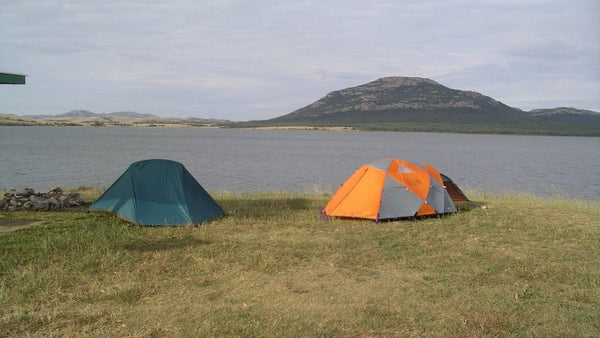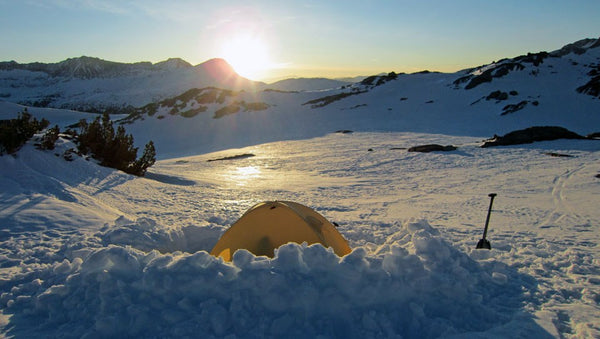by Richard White II
July 01, 2019
Clean Your Camp Kitchen With These Handy Tips!

Cooking in camp is one of the major pleasures of being out in the woods. The fresh air, the smell of the campfire, and sampling the latest creation from the grubmaster. But after all that cooking often there are dishes.
For most dishwashing is probably one of the least enjoyable aspects of camping (I'm a bit crazy but 3 bin dishwashing for me, can be a zen-like activity), but learning how to clean camping dishes is a skill that's necessary if you want to eat. That said, there are some simple ways to wash your dishes while camping that will make the washing process go easier for everyone, and make sure your whole team is back to enjoying the outdoors as quickly as possible and most importantly, No One Get Sick.
The Station
We all know the saying: "whoever cooks, doesn't have to do the dishes," and one of the nicest ways to say "thank you" to your Grubmaster is to take the dish load off their shoulders by being the camp dishwasher. (The grubmaster should create a duty roster identifying the wash crew, before eating, this will set the expectations of the group early)
A great way to do this is to set up your camp dishwashing station while your Grubmaster cooks, that way you have things ready when the dishes are fresh. Cleaning dishes before the food hardens on them is the best way to get your dishes done fast, as letting them get crusty can end up taking you a much longer time to clean.
That's where the traditional Scout dish method comes in handy, with a 3-step process that gets your dishes clean and sanitized, and ready for your next meal.
To make your dishwashing station, find a flat surface like a camp table. You'll need the following items to make a "dish kit" before you leave:
- 3 deep plastic tubs (big enough to fit multiple dishes. This is something to check before heading out. Foot bathtubs are perfect, but if you have a larger group, you might want a larger tub or be prepared to change to water more frequently. Remember - larger tubs will require more water to fill them and will weigh more)
- Biodegradable camp soap (Did you know Campsuds come with the YAK? )
- Scrub brush with plastic bristles
- Sponge with non-abrasive scrubbing side (try cutting one large sponge into 3 mini-sponges for easy packing)
- Bleach or Steramine tablets
- Towels or mesh bags to dry wet dishes
To set up your station, lay out three bins on a flat surface. Fill the first bin with hot water and enough soap to create some mild suds (but be careful to not use too much soap. It won't be as "sudsy" as when you use your dish soap at home.)
Fill your second tub with warm water. This is your "rinse" for the first tub, so you'll be looking to clean the soap off your plate. In your third tub, add more water and your sterilizing agent (a cap full of bleach).
If your dishes are really crusty, set up an extra "pre-soak" washtub and put any dishes with really stuck and dried food in that tub to soak. Use hot water and a little dish soap in your "pre-soak" tub, then put the dishes in until the food bits are soft and come off when you scrape them. Then use your scrub brush to scrub off the food bits until the plate is smooth. Now, you can place the dish in your regular "soak" tub in your 3-bin washing station.
Create a dish-drying station by either laying out towels on another table or hanging mesh bags to put the wet dishes into. You can also have a friend stand at the ready to hand-dry dishes as you wash them. After they are dry put them back into the gearbox for use during the next meal.
Scrape
One of the first steps to learning how to wash camping dishes is to scrape your plate. After you're done eating, you'll need to remove all your leftover food (if there is any) and place it in your trash. Avoid scattering food bits around your camp, as this can attract animals.
For dishes that haven't gotten crusty yet, try to wipe off or eat as much food from your plate as possible. You can wipe the food up with bread, your fingers, or even clean with a paper towel or napkin, but the goal is to get the surface of your plate as clean as possible. Avoid licking your plate, as this can spread saliva bacteria that carry illness.
Wash
Put your scraped dish in the soaking tub, and scrub with a scrub brush or sponge until there are no more food bits stuck to the plate, and the soapy water has thoroughly covered the plate for a couple of minutes. When the tub water gets really dirty, strain out the food bits, replace with fresh hot water and soap, and continue washing more dishes. You can also set up the extra soak station to help this process go faster.
Rinse
After your plate is washed in the soapy water, place in the warm rinse tub and swirl to get the soap rinsed off. You can check to make sure the plate is clean by running your finger over it to see if it squeaks. If you still feel a slippery film, rinse your plate again.
Sterilize
Place your rinsed dish in the sterilizing water for a minute, then remove and dry. You can either towel dry or air dry your dishes, whichever method you prefer best.


In the age of the automatic dishwasher most folks have little to no idea of how to hand wash dishes at home let alone when camping. I still see Scouts washing dishes underneath a community water spigot or, even worse, in a stream or lake.
Good dish washing technique will help you stay healthy (especially on extended trips) and minimize impact in the wild.
Here’s a short version
-
Pre-Rinse – each individual uses a little bit of drinking water to rinse out their dishes and utensils, drinks that rinse water, and then puts their dishes on the wash pile.
-
Hot Water Wash (First Dish Pan) using as little soap as possible the dishes are washed. The cleanest dishes go first, the dirtiest dishes go last.
-
Hot Water Rinse (Second Dish Pan) once all the soapy water has been shaken off the dishes they are rinsed in hot water.
-
Sanitizing Soak (Third Dish Pan) rinsed dishes go into a sanitizing soak.
Once the dishes are clean the dishwater is strained and any remaining food particles are packed out in the trash.
 A set of three plastic dish pans (for car camping), biodegradable dish soap, a dish towel, a dish brush, a nylon scrubby pad, a strainer, and Steramine tablets.
A set of three plastic dish pans (for car camping), biodegradable dish soap, a dish towel, a dish brush, a nylon scrubby pad, a strainer, and Steramine tablets.
Here’s my dish washing gear suggestions –
Campsuds Biodegradable Soap
Steramine Quaternary Sanitizing Tablets
Oxo Palm Brush
Nylon Mesh Strainer
For cast iron and other metal cookware
Inspired Basics Cast Iron Cleaner (see my review here)
Polycarbonate Pan Scrapers
Heat a pot of dishwater on the fire as soon as the meal is served. Once the meal is done the dishpans are laid out and a four step process begins:
First Dishpan
Put a couple of inches of hot water in the first dishpan (if it is too hot you’ll want to add some cold water, so go easy).
Add a small amount of biodegradable soap like Campsuds – about two drops – if more is needed it goes in a drop at a time.
Scouts generally use way too much soap and leave a lot of it on the dishes fouling the rinse water – once they learn to use just a few drops of soap (you can always add more but you can’t take soap out once it’s in the water) and to drain this soapy water off the dishes completely they’ll have a better result.
Second Dishpan
The second dishpan gets a few inches of hot water only.
Third Dishpan
The third dishpan is filled with water (it can be any temperature) and two Steramine tablets. They stay in this dishpan for a full minute fully submerged in the sanitizing solution, drained and laid out to dry. Some sources recommend using liquid bleach in the sanitizing water, I do not. People tend to use way too much bleach (you need onlyone teaspoon for a gallon of water) and Scouts handling liquid bleach is a recipe for disaster.
1. Pre-rinse – Full Stomachs and Empty Plates.
Everyone is responsible to bring their dishes to the wash station as free of food residue as possible (with hungry Scouts this is rarely a problem).
BEFORE you put your dirty dishes in the wash pile Scouts put a little drinking water in their bowl, cup and plate; rinse their dishes and utensils and drink that rinse water. This eliminates about 99% of the food particles that would foul the wash water.
Yuck! – that sounds gross but it’s not a huge deal, makes washing up much simpler and reduces the amount of dirty water that needs to be disposed of.

Triage – Wash the least dirty dishes first, work towards the dirtiest, and then wash your pots and pans Always save greasy pans for last The dishes go in a few at a time and are scrubbed with a dish brush. Before they head to the next step they are drained carefully to eliminate as much soapy water as possible.
Pots and Pans – Once all of the plates, bowls, cups and utensils are washed the pots and pans are next. Instead of the pots going in the dishpans some of the water from the dishpans goes into the pots, but only enough to get them clean.
We do not try to clean the exterior of sooty pots and pans – there’s really no need to do this, just brush off loose soot and clean the inside of the pot. A scrubbing pad may be needed, and that pad should stay in the pot- not in the dishpans. If the scrub pad gets really grubby rinse it out with some clear water.
Especially greasy pots and pans need to be tested before they are rinsed – rub a finger inside the pot if there’s grease there you will feel it and you need to wash it with soapy water a second time. As don’t pour the wash water back into the dishpans, strain it and broadcast or pour it into the sump.
 After the dishes are washed and all the soapy water has been shaken off them over the first dishpan they go in the second pan for a hot water rinse. Use a cup or bowl to pour rinse water over your dishes.
After the dishes are washed and all the soapy water has been shaken off them over the first dishpan they go in the second pan for a hot water rinse. Use a cup or bowl to pour rinse water over your dishes.

Put rinsed dishes in the third dishpan for a full minute fully submerged in the sanitizing solution, then they are drained and laid out to dry. Pots and pans go through the sanitizing step by pouring the solution in them and swishing it around to sanitize the entire inside of the pot.
Rinsing the dishpans – Strain the dirty water using a kitchen strainer to remove as many food particles as possible and put the food particles in your trash. Carry dishwater and rinse water away from your camp and at least 75 steps from any streams, lakes, campsites, or trails. Give the water a good fling with a long sweeping throw to spread it over a large area. Broadcast the strained dishwater in a sunny area if possible so it will evaporate quickly, causing minimal impact. No sanitize your bins by pouring the sanitized water from the third pan into the rinse bin while it is standing, use your sponge to scrub the bin sides and let it stand for a minute, then transfer the remaining water to the soap pan repeating your scrubbing and let stand for a minute before broadcasting the sanitizing water.
Help, No Soap!
But what if someone forgot the dish kit? In the event of this calamity, you can still get your dishes clean with this camping dishwashing hack: try cleaning off as much food debris as possible, then make a paste of wood ash from your campfire and water. Use this paste to scrub your plate like you would use soap, then rinse with purified water before letting your dishes air dry. Wood ash contains the lye that is normally used to make regular soap, so you're essentially using nature's soap!
By utilizing this handy dish-washing method, you can keep your whole Patrol's dishes clean, and take as little time as possible to get the whole job done right. This setup is best used for a static-based camp where you won't be packing up right away, as the dishwashing kit can get a bit heavy.
If you're backpacking and can't carry a dishwashing kit, use towels and bread to keep your plates wiped up, and try the wood ash method if you really need to clean a dish.
Do you have and dishwashing tip? Let us know in the comments.
Till we see each other through the smoke of the campfire.
Leave a comment
Comments will be approved before showing up.

 A set of three plastic dish pans (for car camping), biodegradable dish soap, a dish towel, a dish brush, a nylon scrubby pad, a strainer, and Steramine tablets.
A set of three plastic dish pans (for car camping), biodegradable dish soap, a dish towel, a dish brush, a nylon scrubby pad, a strainer, and Steramine tablets.
 After the dishes are washed and all the soapy water has been shaken off them over the first dishpan they go in the second pan for a hot water rinse. Use a cup or bowl to pour rinse water over your dishes.
After the dishes are washed and all the soapy water has been shaken off them over the first dishpan they go in the second pan for a hot water rinse. Use a cup or bowl to pour rinse water over your dishes.







Richard White II
Author